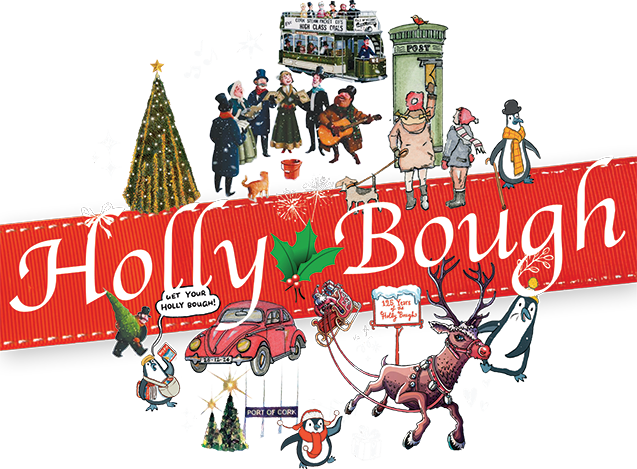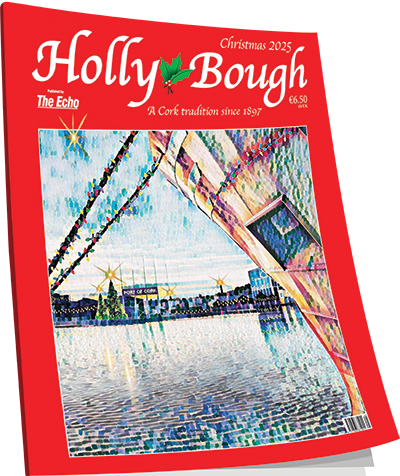Echo 130: 10 memorable sporting moments as covered by The Echo
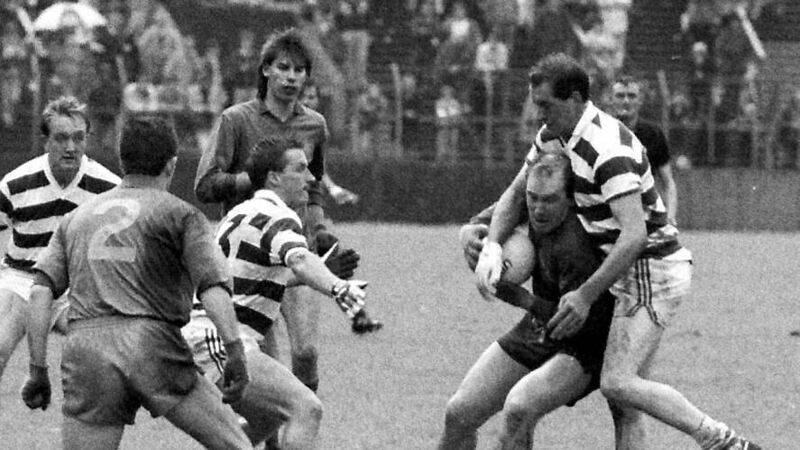
IT’S hard to imagine the 50th anniversary of one of the most memorable achievements in Cork football is only around the corner.
It was a different world back then, almost a sense of innocence compared to modern cynicism and it was definitely different with the then .
Imagine scoring five goals against the old enemy Kerry in a nine-point Munster final success and not even mentioning it on page one? Sport knew its place.
It was a time of the old 12-page broadsheet with sport condensed into three, a back page consisting of a minimum 10 stories and two inside, a right licorice allsorts.
‘A master plan that worked like magic’ was the intriguing headline accompanying Michael Ellard’s insight to that great July 15 day, which attracted a 28,859 attendance, paying gate receipts of £11,830.
And, yet, when likened to current tactics, it would barely get noticed, but Cork had a plan and it worked brilliantly.
Such was the secrecy surrounding the ploy that the players were only informed of it just before taking the pitch and it seems it took a while for the whole management team to come around to trainer Donie O’Donovan’s thinking.
It clearly worked because Cork led by 5-4 to 0-6 at half-time after Jimmy Barrett (2), Billy Field, Barry-Murphy and Dinny Long rocked the Kingdom with a flurry of goals.
The page also included two photos from the game, a piece on Cork’s minor victory, along with eight other items, ‘On the fairway with Max Faulkner’ being one.
While the goal-scoring feats of the Cork forwards were lauded wide and far the performance of goalkeeper and captain Billy Morgan also came in for special praise.
He earned the plaudits of his colleagues with a string of crucial saves, notably in the second half when Kerry started eating into Cork’s advantage.
Cork had qualified for the customary old firm provincial final by disposing of the Clare challenge by 2-14 to 0-3, also at the old Athletic Grounds, Field contributing 1-8 and Barry-Murphy 1-2.
coverage reflected a sort of ‘so what’? about the game, wrapping it up in a look back at the weekend’s football championship action, Kerry’s win over Tipperary and Offaly successful in Leinster, unworthy, it appeared, of even a match report.
There weren’t even photographs of the Cork game, but a couple from Kerry-Tipp did manage to find their way into the other pages for some reason or other.
Cork now turned their attentions to an All-Ireland semi-final against Tyrone on August 19 and the razor-sharp forwards ripped the Ulster champions apart, once more hitting the net five times in a 5-10 to 2-4 rout with Barry-Murphy (2), Cummins, Seamus Coughlan and Declan Barron scoring.
The only blot on the afternoon was the leg break suffered by Field, who had contributed 2-14 in the two previous games and was forced to sit out the biggest day in the football calendar.
‘Operation emulation’ was the Cork war-cry going into the game after critics suggested they couldn’t repeat their goal-scoring feats outside the county.
Qualifying for an All-Ireland final still didn’t impress the Editor, who ignored the achievement on page one while the footballers also had to leave space for Celtic’s win over Hibs in the first Cork derby of the soccer season as well as a motorbike scramble in Youghal and Eddie Polland’s Ryder Cup selection.

The September 24 edition, however, did carry an action pic of the famous win over Galway on the cover while the back page headline ‘Glory on ye’ men of Cork’ struck a chord, marking an end to a 28-year wait for Sam’s arrival home.
There’s a fine action study of Morgan in action, another of O’Donovan and Ned Kirby with the ball as well as a team picture taken from an interesting angle.
He mesmerised his audience with an array of trick shots off either foot before dropping to his knees on a towel and hitting a ball 200 yards.

IT was five years in the making, but the first national league for the country’s leading rugby clubs eventually got off the ground in 1990.
Initially, the AIL had two divisions, one of nine clubs and another of 10, playing one round of fixtures to determine the champions.
The best three from Munster, Cork Constitution, Garryowen and Shannon, Leinster, Lansdowne, St Mary’s and Wanderers and Ulster, Ballymena, Instonians and Malone, formed Division 1.
Much of the chatter came from Dublin and Belfast about who was going to do what and win what, while Munster’s trio confined their talking to the pitch, the only place that mattered.
Previously, clubs played in their own provincial leagues with a scattering of friendlies thrown in before the main business of the cup after Christmas, and there was minimal interest.
The AIL changed that, particularly as the opening competition came down to the last day and a meeting of the top two, Garryowen and Con in Limerick.
Over 10,000 people crammed into the tight surrounds of Dooradoyle, some climbing trees for a bird’s eye view.
The pair were level on 12 points, suffering just one defeat apiece with Lansdowne in close proximity.
All the advantages lay with Garryowen, whose superior scoring difference of +52 to Con’s +35 meant a draw would have sufficed.
Conditions were typical for the time of year, an overnight frost thawing to ensure a soggy and demanding surface that tested players’ fitness levels and handling skills.
As expected, it was a forwards-oriented encounter with Garryowen on top in the line-out, where Paul Hogan, John Mitchell and Richard Costello lorded.
Con, though, had a stronger scrum and this proved decisive as matters unfolded, with Philip Soden, Paul Derham and Paul McCarthy an imposing front-row.
That critical area of the game became the central point during the second half when the sides were tied at 3-3.
Con captain Michael Bradley turned the Garryowen defence with a clever kick in behind and the pressure was on the home side once again.
Con’s scrum earned a succession of penalties before number eight Victor Donnelly picked and went only to lose possession as he was touching down.
There was no reprieve for Garryowen, however, because from their own put-in out-half Nicky Barry was forced to concede another scrum after hounded by Bradley and flanker Ollie Barrett.
Eventually, after more scrums and over eight minutes in all camped on the line, referee Denis Templeton’s patience ran out and he awarded Con a penalty try, converted by Ralph Keyes.
Both midfield defences stood up to the task with Con pair Charlie Murphy and Niall Murray and opposite numbers Phililp Danaher and Kenny Smith effective in restricting opportunities.
Garryowen dictated play in the closing stages and Smith twice saw penalties rebound from the uprights.
He was also involved in a game-defining moment late on as Smith’s pass to wing Richard Wallace had major possibilities until McCarthy appeared from nowhere to pull off a try-saving tackle. Moments later, the final whistle prompted emotional scenes as Con players and supporters celebrated their historic triumph.

It was the first of nine successive Munster triumphs - Shannon (4), Con and Garryowen two each - before St Mary’s broke the sequence.
K Murphy; D O’Dowd, N Murray, C Murphy, B Walsh; R Keyes, M Bradley, captain; P Soden, P Derham, P McCarthy; D Lynch, S Hayes; L Dineen, V Donnelly, O Barrett.
It featured the best hammer throwers on the planet in world champion and record holder, Sergey Litvinov, and twice Olympic champion, Yuri Sedykh, and the fastest women 800m runners that year, Lubov Gurina and Irina Podyalvoskaya, as well as 5,000m runner, Valeriy Abramov, and the country’s leading miler, Alexander Kostetski.

Yet, six came in the opening half and were evenly shared with Wexford, who were missing three key players, matching Cork’s three, but could do little to prevent their opponents’ point-scoring exploits.
Captain by goalkeeper Paddy Barry from St Vincent’s, Cork’s scoring was widely spread, O’Brien finishing with 3-1, McCarthy 1-9, Walsh 1-2 and Tomas Ryan 0-6.

IT’S fitting that 130th anniversary celebrations coincide with one of the great sport occasions in the country’s history.
Sunday, June 12, 1988, is a date forever etched in the memory, after the Republic of Ireland’s historic qualification at a major soccer tournament began with the high of defeating the old enemy England 1-0 in the opening European Championship Group 2 game.
Ireland had qualified by virtue of Scotland’s victory away to Bulgaria, and while the newcomers barely earned a mention in discussing possible champions, just being one of the eight countries to qualify for the finals in West Germany more than sufficed.
Ireland were also pitted with Holland and the Soviet Union, with two teams to emerge for the semi-finals.
The hosts were joined by Italy, Spain and Denmark in Group 1 and Jack Charlton’s side were considered the rank outsiders.
Ireland’s debut at a major finals was pencilled in for the Neckarstadium in Stuttgart in the south of the country, a ground with a capacity of 51,373.
East German referee Siegfried Kirschen took charge of a match featuring club colleagues in England facing each other on opposite sides on a boiling hot afternoon.
Tensions intensified after the curse of the English game spread to central Europe that weekend, as hooligans cut loose in the city centre, starting fights, destroying property, and creating mayhem generally.
Extra police patrolled the ground just in case of any further violent outbreaks, and their unease was compounded when Ireland took a shock early lead with Ray Houghton’s famous headed goal.
Thereafter, England pummeled the Irish penalty area, but try as they might, the defence, marshalled brilliantly by Kevin Moran and Mick McCarthy and inspired by keeper Packie Bonner, remained defiant.

The usually reliable Gary Lineker scorned chances to equalise, with the frame of the goal coming to Ireland’s rescue as well, before the final whistle prompted wild scenes on the pitch and on the terraces packed with Irish fans.
The broadsheet , as it was known back then, didn’t go overboard on the Saturday before the game. Page one carried 11 stories, slotting in the team announcement in a brief, while the back page centred on Moran’s future at Old Trafford.
Monday’s edition, though, was very different and captured the mood perfectly, the main news page honing on those eager to join the party for the second game against the Soviet Union in Hanover on the Wednesday.
‘Let’s go...’ was the banner headline over a story about the search for those elusive tickets and the dash to get to Germany in time.
The main photograph was of Irish fans celebrating at the final whistle and there was no disguising their unbridled joy at the result.
‘Home fans in ticket frenzy’ accompanied the piece, while underneath there was still no escape the English rioters. ‘The yobs - English hooligans arrested’ ran the headline.
It had three articles, from Noel Spillane and yours truly at the game, and an opinion piece from Sports Editor Billy George, with three pictures decorating the page, including of a clench-fisted Houghton at the conclusion.
In those days usually had just four sports pages with the occasional spillover to an adjoining advertising page. The occasion demanded more and the reader was treated to another full page inside, well presented with a nice balance of reports and pics, including the shock story of the Soviet’s 1-0 victory over a more fancied Dutch side.
It began one of the most riveting weeks in Irish sport as the country was on tenterhooks ahead of the Soviet game and the crunch tie with the Dutch the following Saturday.
got the pulse of the city immediately and maintained its impressive coverage throughout.
And while there was ultimate disappointment at not reaching the semi-finals, drawing 1-1 with the Soviets and losing 1-0 to a late Dutch goal, the country’s spirits were truly lifted.

RARELY has a team won a League of Ireland title in the gruelling manner in which Cork City were crowned champions almost 30 years ago.
It was crammed with drama, excitement and controversy on a memorable journey, which encompassed 38 games, the last six in two sensational series of play-offs.
The season marked the eighth of the Premier Division and contained 12 teams, including Dublin’s quartet of Bohemians, Shelbourne, Shamrock Rovers and St Patrick’s Athletic.
City were joined by Munster rivals, Limerick and Waterford United as well as Dundalk, Derry City, Drogheda United, Sligo Rovers and Bray Wanderers, all playing each other home and away.
After those 22 games, the league was divided in two, the top six playing for the title and the bottom six to stay in the division with three relegated.
Again, it was home and away, 10 more games producing a last-day-of-the-season story that only Hollywood could have scripted.
Bohs held the advantage, three points clear of Shelbourne and City, who duly overcame Limerick 3-0 though Shels needed a last-minute Paul Doolin goal against Derry.
Bohs required a point from their visit to Dundalk, but their day turned into a nightmare as the bus broke down and were late arriving at Oriel Park.
And to compound matters, Tom McNulty scored the only goal which meant a three-way tie at the top, level on 40 points.
This still couldn’t determine the outcome as the trio finished on four points and the same goal difference of zero, prompting a second play-off series at ‘neutral’ venues this time.
City used Turner’s Cross instead of Bishopstown for the visit of Bohs and Pat Morley’s 19th goal of the season after 39 minutes decided the contest.
It left City’s destiny in their own hands three days later, when they travelled to play Shels at the RDS in as dramatic a game you would have wished and a fitting climax to the marathon campaign.
Morley’s header put City one up before Shels levelled from the penalty spot though Dave Barry edged City 2-1 in front with a super finish following a very clever step-over by Morley.
Back came Shels, however, and a frantic scramble in the City area ended with Anto Whelan firing in a second equaliser, 2-2.
City grabbed the winner via an unlikely source, centre-back Paul Bannon got on the end of a Gerry McCabe cross and his outstretched leg managed to lob the ball into the far corner of the net with Morley lurking to make sure.
It ensured the title returned Leeside for the first time since Cork Celtic’s success in 1974 with City playing 38 games in all, winning 19, drawing 10 and losing nine.

coverage of the season’s climax captured it brilliantly with Noel Spillane’s excellent reporting and Eddie O’Hare’s eagle-eyed photographs.
‘Capital City’ roared the front page headline, now tabloid from broadsheet, and a great picture of Cormac Cotter’s joy at being crowned champions.
Inside a two-page picture special showed all the emotions of a roller-coaster game in an equally frenzied season under the banner headline ‘Follow the Lee-ders’!
For manager Noel O’Mahony, it was his day in the sun at last after fruitless FAI Cup finals and a league title loss against Dundalk at the Cross.
“We have broken the mould at last,” he said at the time.
“There is incredible potential in the club and, hopefully, this championship success is only a beginning.”
NO event captured the transformation in newspaper publishing more than Munster’s historic 23-19 Heineken Cup victory over Biarritz at the Millennium Stadium, Cardiff, 16 years ago.
The printing world has come a very long way from the original days of manual presses to state-of-the-art technologies to feed the habit of those demanding instant news.
An estimated 60,000 Munster fans travelled from seemingly everywhere on the planet to witness first-hand the day Declan Kidney’s band of heroes finally delivered the Holy Grail.
Having come agonisingly close on a couple of other occasions to Northampton Saints and Leicester Tigers, Munster, at last, commanded centre-stage on the most memorable of occasions in the Welsh capital.
An abiding memory after the game was hundreds of fans flinging a rugby ball around the main street leading to the stadium, stopping whatever traffic tried its luck to manoeuvre a way through all under the gaze of laughing policeman.
The ’game’ only stopped, when the Munster bus came along and pandemonium broke out once again without a hint of trouble.
I remember one copper saying he was fortunate to be working that Saturday and off on the Sunday because Leeds United fans were in town for a promotion play-off. Different story!
A deal was struck with the publishers of the Western Mail, the biggest paper in Wales, to print 10,000 copies and distribute them free to supporters.
It went down a treat, the cover announcing ‘Champions of Europe’ and a photo of scrum-half Peter Stringer, the man of the match, diving over for his crucial try.
The pocket-rocket number 9 entered the folklore not only of Munster and Irish rugby but sport in general with his famous try, which caught the French blissfully unaware.
It’s still fresh in the mind, Munster with a five-metre scrum close to the right corner and Biarritz wing, Bobo, scorer of a second-minute try himself, leaving the door open for Stringer to break down the blindside and dive spectacularly over the line to the deafening cheering of the Munster supporters.
Monday’s Echo was a monster 86-page epic, enough newsprint to have levelled a half-decent forest, but nobody cared.

The coverage bordered on the hysterical, page one paying tribute to the famous scrum-half with a banner headline of ‘Stringer the Stinger’, accompanied by a beaming smile holding the trophy aloft.
There must have been a dozen news pages devoted to the historic game, including an interesting story about local bookmakers Cashmans, who lost their shirt on Munster’s triumph.
‘Cork bookie elated despite losing £1m’ ran the headline over an article outlining how Munster were 25/1 at the start of the competition and one punter was about to collect on his £20k bet at 20/1.
The back page carried a photo of Donncha O’Callaghan and Stringer lifting the cup high into the night sky on the lap of honour with ‘Leeside legends pay pivotal role in victory’ sandwiched in between.
It brought an end to a journey that captivated a nation, Munster’s pursuit of ultimate glory finally achieved after so many heartaches.
It had all begun in defeat, Munster losing to Sale in the opening Pool 1 game, but then winning the next five, including the revenge 31-9 defeat of the English club at Thomond Park to close out the qualifying phase.
Munster and Sale finished on 23 points, but the bonus point collected helped the future champions top the section and earn a home quarter-final after squeezing into four place in the seedings.
Victory over Perpignan set up a mouth-watering semi-final with the old enemy, Leinster, and a capacity 47,800 Lansdowne Road, on a gloriously hot afternoon, witnessed Munster continue their dominance with a 30-6 success, highlighted by a late Ronan O’Gara try and subsequent celebrations with adoring fans.
Then, it was off to Cardiff by whatever means possible to proudly say ‘I was there.’
THE Big Three had an uninvited guest during the 102nd staging of the county senior hurling championship 32 years ago.
For decade after decade, Blackrock, Glen Rovers and St Finbarr’s ruled over the city and not since Redmonds in 1917 had any one dared break their monopoly.
They amassed a grand total of 60 counties between them by the time came around once again to determine the destination of the Sean og Murphy Cup in 1990.

The Glen had ensured the famous trophy crossed the river to the northside on 25 occasions with the Barrs claiming it 20 times and the Rockies 15.
Then came Na Piarsaigh, the great under-age nursery on Fair Hill, a club which churned out great hurlers year after year only for the Holy Grail to elude them in 30 years’ efforts until it all changed with the late Eamonn Ryan central to their arrival on the big stage.
Back then the championship was a no-frills competition, lose the first round and that was it for the season, no back doors, no secondary championship. Winner takes the lot.
An eight-point win over Ballyhea in round 1 set-up a quarter-final against Midleton, who had beaten them in the 1987 decider, with Piarsaighs prevailing by five points, 2-12 to 0-13.
The mighty Rockies awaited in the semis, but it was no contest as the newcomers strutted their stuff in the grand manner, romping to a 2-17 to 1-4 rout and a place in the final against the Barrs.
Na Piarsaigh seemed poised for victory only for an equalising goal from a Brian Cunningham free to break their hearts in a 1-12 to 3-6 draw and another day out.
And so a crowd of 19,151 assembled at Páirc Uí Chaoimh on October 21 to witness another gripping contest with the northsiders at last savouring victory by 2-7 to 1-8 but not before more late drama.
A two-point lead is nothing in hurling and when John Meyler gained possession in the last minute, Na Piarsaigh hearts stopped, but his effort whizzed inches outside the post.
It was a terrific contest once more, the 34-year-old Richie McDonnell setting the tone by doubling on a ball 95 yards out for an amazing fifth-minute point.
Na Piarsaigh led 1-5 to 0-5 at half-time after playing with the wind, James O’Connor netting 20 minutes in, first-timing to the net after his initial kick was blocked.
And he struck a second time, three minutes on the resumption, as Na Piarsaigh sensed victory, their challenge built on a brilliant half-back line of captain Christy Coughlan, Leonard Forde and Christy O’Donovan.
The Barrs fought back with a Michael Barry goal reducing the deficit and creating unbearable tension.
It didn’t matter Na Piarsaigh didn’t score again in the closing 20 minutes and they registered twice as many wides, they had arrived.
Page 1 carried the headline ‘The Boys of Fair Hill’ alongside a beaming O’Sullivan with cup in hand.
The back page had a team photo under the headline ‘Northern Lights’ with former player Michael Ellard describing the club’s journey to be finally crowned champions.
Inside another former player, Eoin Edwards, a sub-editor with , wrote what it all meant under the headline ‘The team on the Hill climb Everest.’
Barry Roche got Justin McCarthy’s views on the big game. “Na Piarsaigh’s greater determination and appetite got them through. They had great heart,” he said.



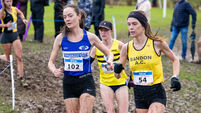
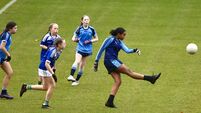

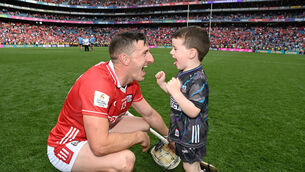


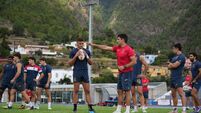
 App?
App?






